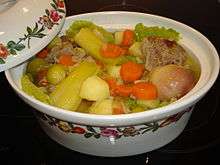Hutspot
|
| |
| Place of origin | Netherlands, Belgium |
|---|---|
| Main ingredients | Potatoes, carrots, onions |

Hutspot (Dutch), hochepot (French), or hotchpotch (English), is a dish of boiled and mashed potatoes, carrots, and onions with a long history in traditional Dutch cuisine.
History of the dish
According to legend, the recipe came from the cooked potato bits left behind by hastily departing Spanish soldiers during their Siege of Leiden in 1574 during the Eighty Years' War, when the liberators breached the dikes of the lower lying polders surrounding the city. This flooded all the fields around the city with about a foot of water. As there were few, if any, high points, the Spanish soldiers camping in the fields were essentially flushed out.
The anniversary of this event, known as Leidens Ontzet,[1] is still celebrated every October 3 in Leiden and by Dutch expatriates the world over. Traditionally, the celebration includes consumption of a lot of hutspot.
Hutspot is normally cooked with klapstuk in the same vessel. Klapstuk is a cut of beef from the rib section. It is marbled with fat and responds well to slow cooking in hutspot. If klapstuk is not available, then smoked bacon is commonly substituted. The carrots used are generally of the type known as winterpeen (winter carrots), which give the dish its distinctive flavour ordinary carrots cannot match.
The first European record of the potato is as late as 1537, by the Spanish conquistador Juan de Castellanos, and it spread quite slowly throughout Europe from thereon. So the original legend likely refers to what the Dutch call a 'sweet potato' or pastinaak which is a parsnip; this vegetable played a similar role in Dutch cuisine prior to the use of the potato as a staple food.
The term hutspot (which can be roughly translated as "shaken pot") is similar to the English term hotchpot and Middle French hochepot, both of which used to identify a type of meat-and-barley stew that became synonymous with a confused jumble of mixture, later referred to as 'hotchpotch' or 'hodge-podge'. In noting the etymological connection, the Oxford English Dictionary records 'hochepot' as a culinary term from 1440, more than a century before the Siege of Leiden.[2] In Melibeus (c1386), Chaucer wrote, "Ȝe haue cast alle here wordes in an hochepoche", but that early use probably referred to its legal sense in English law (recorded from 1292) as a blending of properties. Later uses certainly referred to its culinary sense.[3][2]
Similar foods
Related Dutch mashed potato dishes such as stamppot include boerenkool ("farmers' cabbage" or kale), andijvie (endive), spruitjes (brussels sprouts) and/or zuurkool (sauerkraut), generally with some rookworst (smoked sausage) or smoked bacon. The chunky texture of the dish distinguishes it from other more smoothly pureed potato-based dishes. More a hearty meal than a side dish, hutspot is very popular during the long Dutch winter. The Swedish dish rotmos – "root mash" – is similar, save for the onions which are substituted with swede (kålrot). Despite the similar name, it is a distinct dish from the Flemish hutsepot, a meat stew with unmashed vegetables.
References
| Wikimedia Commons has media related to Hutspot. |
- ↑ "Events - Netherlands American Society". Nassocal.org. Archived from the original on 2012-05-30. Retrieved 2012-05-21.
- 1 2 "hotchpot". Oxford English Dictionary (3rd ed.). Oxford University Press. September 2005. (Subscription or UK public library membership required.)
- ↑ "The Harleian ms. 7334 of Chaucer's Canterbury tales. Ed. by Frederick J. Furnivall". University of Michigan.
